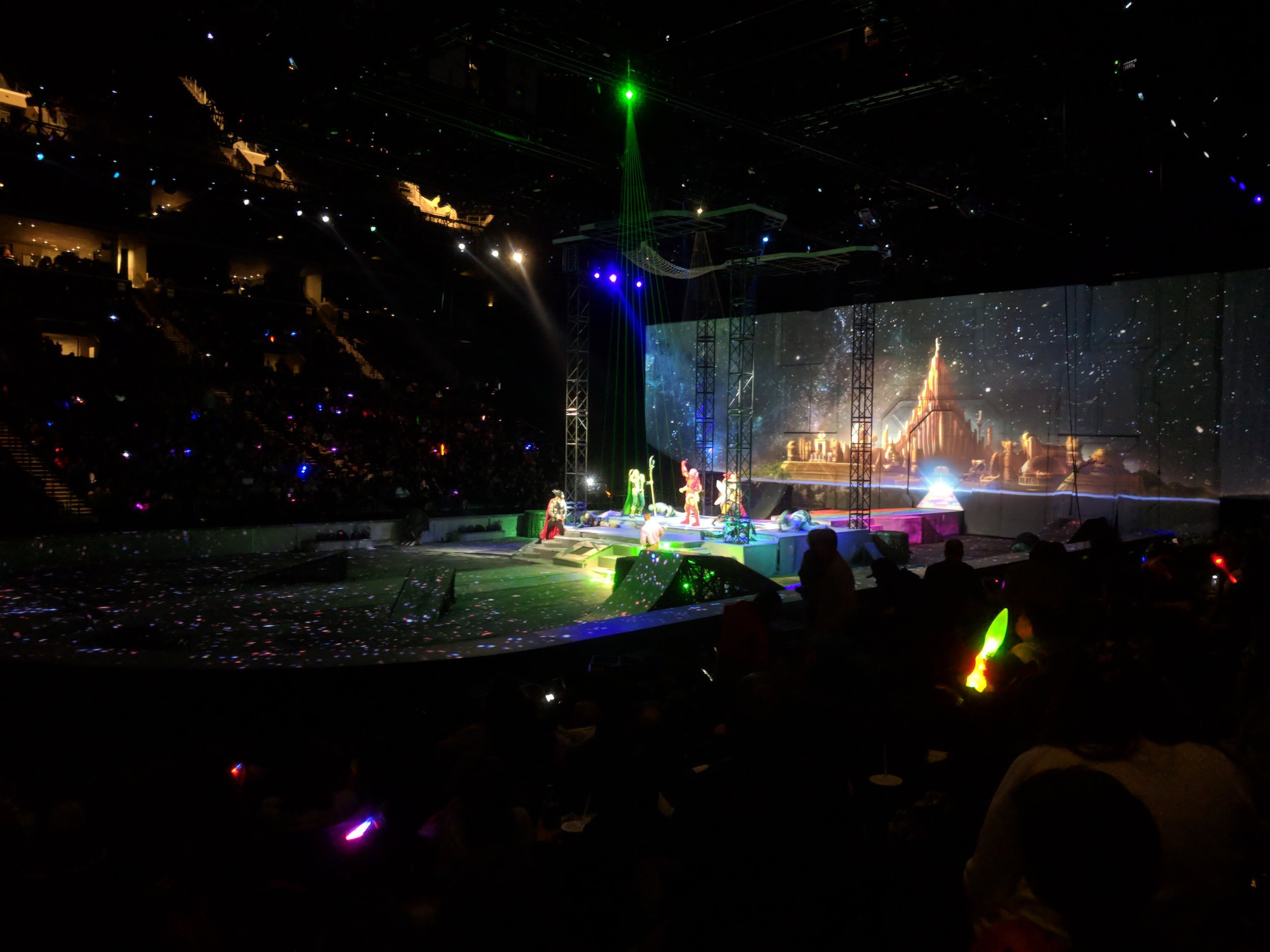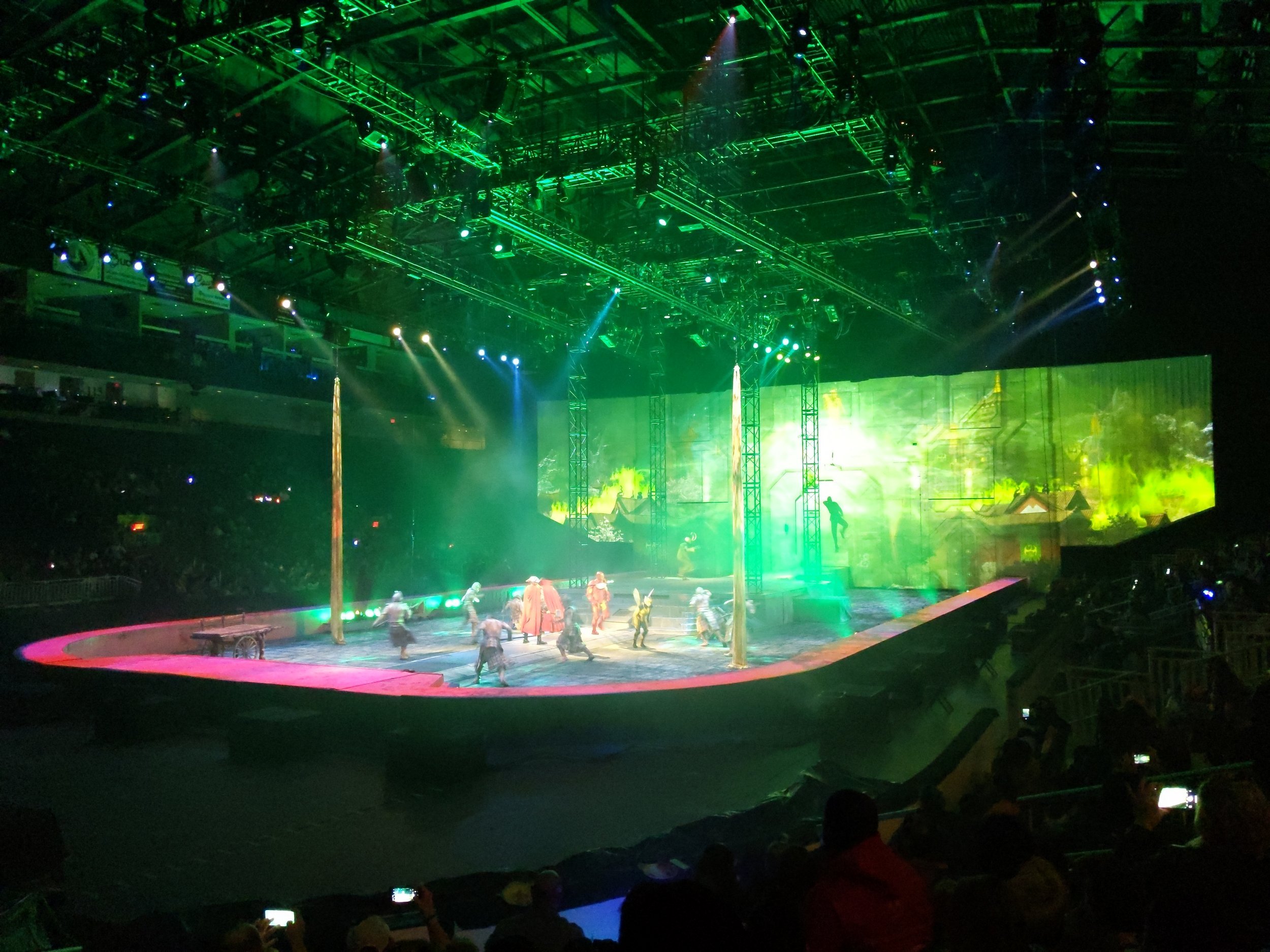George Lucas Super Live Adventure and its connections to Marvel Universe Live!
For someone who really was never much of a comic book fan, it’s pretty strange that I’ve now seen Marvel Universe Live! three times. Why did I see this show so many times? Because it’s a spectacular and remarkable technical achievement. I’m on sabbatical this semester working on a bunch of articles about the evolution of live show technology and its impact on current story telling techniques, and Marvel Universe Live!, I think is a show technology milestone in a long line of shows, and belleweather for the future. The first version opened in 2014, and version two, Age of Heroes, started touring in 2017. I saw the original version in Tulsa back in 2015, and Age of Heroes both here in Brooklyn and up in Bridgeport, and got a very nice back stage tour the last two times I saw the show.
Marvel Universe Live! is basically a stunt show, with amazing performers in the roles of the various Marvel characters, who have to recover some orb thing to (of course) save the universe. And from a production aspect, it’s remarkable, and uses just about every arrow in the quiver of the modern live technology story teller: scenery, lighting, sound, pyro, amazing puppetry, automated rigging, lasers, video mapping—you name it. The entire thing is run on time code, so once the first act starts it goes until intermission unless there is a problem. The fight choreography can only be so accurately timed, so sound effects for the punch sounds and so on are triggered by a technician using a keyboard. In addition, each of the performers (and even some of the set pieces) is tracked using Blacktrax, where each person or item to be tracked is fitted with a small pack with several emitters; the 3D position of each performer is then tracked by a large array of cameras positioned on the massive truss system over the stage. This position information is then sent to WYSIWYG, which positions each moving light to track the appropriate performer on a scene by scene basis (there are no followspots on the show), and to the Disguise (D3) video system for video motion tracking, and the laser projector system. It’s pretty cool and pretty remarkable, and incredible that they move this massive show from arena to arena each week.
As I write this, the show is wrapping up it’s US run, but it’s on its way next to Europe and if you’re interested in show technology I really recommend seeing it.
The Super Live Legacy
It’s fascinating to me the parallels between Marvel Universe Live!, and it’s long-lost 1990’s predecessor George Lucas Super Live Adventure. GLSLA is so forgotten that it doesn’t have a Wikipedia page, but I have a bunch of friends who worked on it, including my former (and sadly no longer with us) boss George Kindler, so I’ve been hearing stories about it for many years. Since it’s quite possible you’ve never heard of it, let’s go over it a bit.
The website Tested did probably the best writeup on the show, and interviewed the director Scott Faris, the production designer Douglas Schmidt , and my friend sound designer Jonathan Deans. They also made a short video that tells the story and shows some pretty good photos and so on, it’s probably best to watch this if you haven’t seen it:
And here’s a Japanese advertisement:
There’s also some information on the show here, a report from a cast member here, and 9 parts of (vintage quality) video from the show here.
GLSLA Tech
The technology on Super Live was pretty astounding, especially for the time. But from our perspective here, what’s most interesting to me is how much of it was custom made. And, I remember George (and Damon Wooten and Jeff Berryman) talking about quite a bit of interactivity, which Scott Faris discussed in the interview:
And our laser guys worked out a system of interlocking safeties so an infrared beam would target on the chest of a stormtrooper and when it got positive feedback it would fire the laser, and when the laser fired a squib charge would go off on the stormtrooper, and he'd fall and die. It looked just like the movies."
JT Tomlinson, who also worked on the show expanded on this 10 years or so ago for an interview I put into my book:
Show control for GLSLA [Super Live], was a Golder Group system, specified by myself, then designed and built by Damon Wootten, with George Kindler as consultant. Damon previously worked for Charlie Richmond,who recommended him to me for this show. We used show control to trigger multiple systems on commands from the stage manager, and also to sync various systems via time code from the LCS/Doremi sound system (LCS serial number one!) or 35 mm film projectors. Commanded systems included lighting, automated scenery, projection, lasers, fog effects, and pyro. One real challenge during production was getting SMPTE from an optical film sound track! GLSLA and KÀ are also similar in that regardless of the amount of computerized controls, neither show is/was automated in the theme park or cruise ship sense; i.e., all or mostly to time code. GLSLA and KÀ are both cued in the classical theatre fashion: a calling Stage Manager maintains the pacing. We had good help on Superlive, including the fine fellows mentioned above, and these current Las Vegas players: JT Tomlinson (now Head of Automation at KÀ) was Technical Director, Todd Toresdahl (now Head of Automation at Mystere) was Head Carpenter,Bill Wendlandt (now Assistant Head of Automation at KÀ) was Assistant Carpenter, Keith Bennett (now Production Manager at Mama Mia) was Head Electrician, JO Henderson (now Lead Automation Operator at O)was the Show Control operator, and Jonathan Deans (now Cirque Sound Designer) was Sound Designer.
Connections, Differences, and Advancements
Many of the innovators from Super Live went on (as JT details above) to have long careers backstage throughout the industry, and the director Scott Faris continued to work on these kind of shows, right up through the recent Walking with Dinosaurs. And while as far as I know, no one on the production team from GLSLA worked on Marvel Universe Live!, it’s actually the same producer, Kenneth Feld and Feld Productions.
But there is a technological heritage as well. A lot of what was hand made and groundbreaking on Super Live is now widely used technology that can be purchased off the shelf. And technology has made the integration simpler—today we have Ethernet. But the massive sets on Super Live, which may have killed the show’s touring future, today could be done with video mapping as they do on the Marvel show (see the following series of photos):
The Blacktrax tracking makes the positional tracking practical; the one big difference I see is that, like so many modern shows, Marvel Universe Live! is for the most part locked down in time, synced to time code.
But all these things—plus so many other innovations of the last 25 years or so—make a show like Marvel Universe Live! practical and cost effective, where Super Live was not. And Jonathan makes this point in the Tested article five years ago: "To do that show now would be stunning. … All the technology, we could do that easily now, in every aspect. Technology has grown up and we'd be able to do that in our sleep almost. But of course, we'd make it a lot better."





